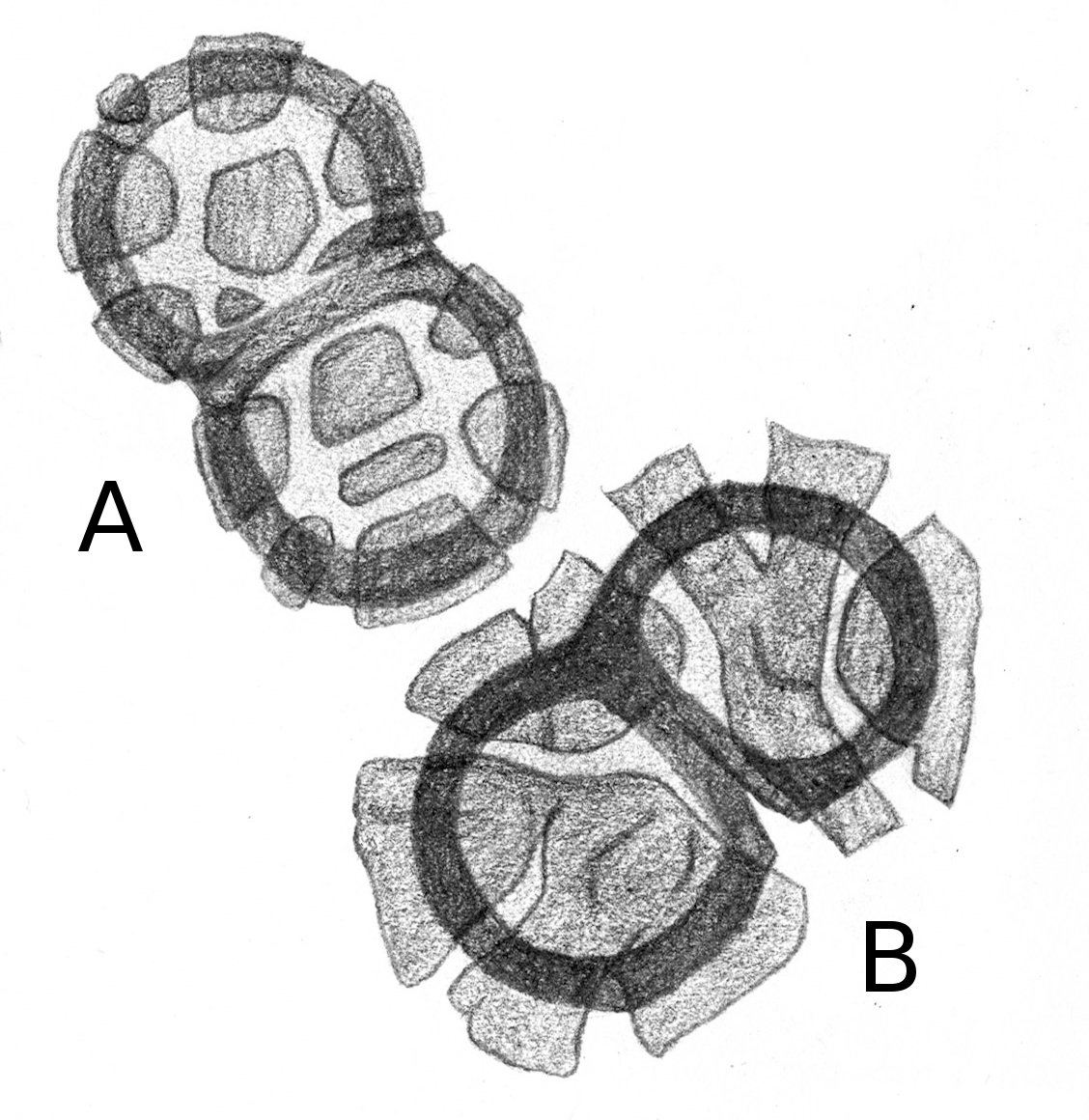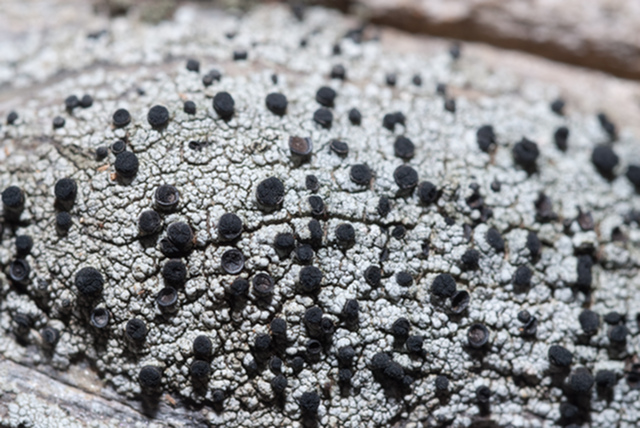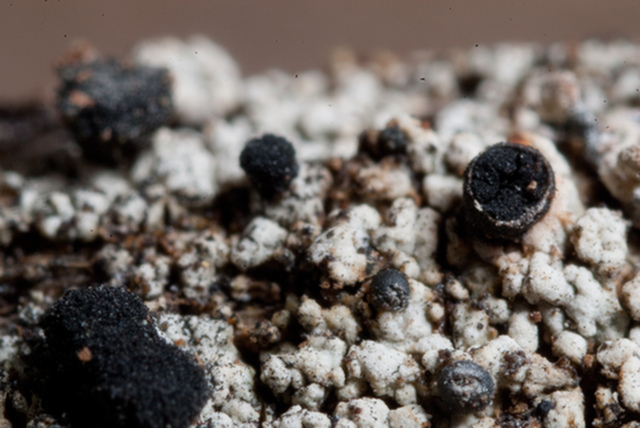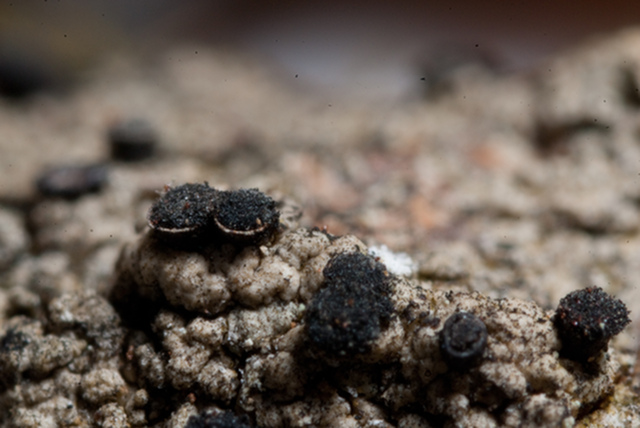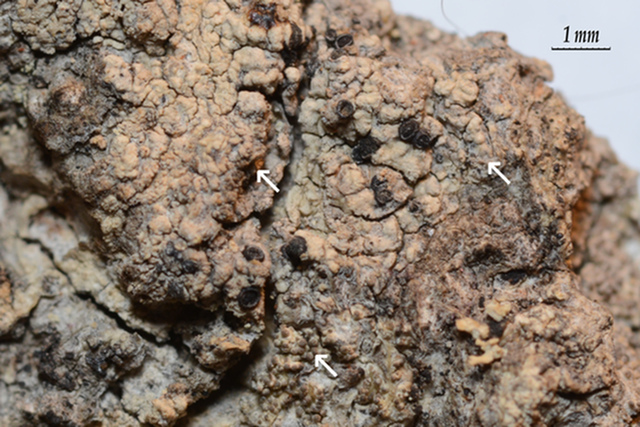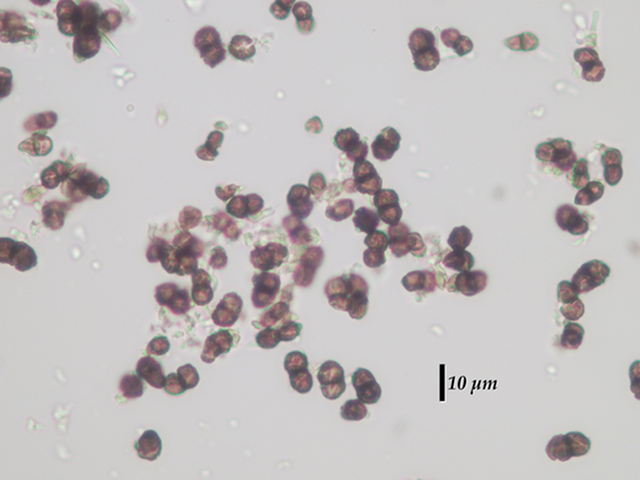- HOME
- Introduction
- History of "Caliciales" and the Origin of the "Calicioids"
- Biogeography of Calicioids
- Calicioid Ecology and Habitats
- Conservation
- Zen and the Search for Calicioids
- Collecting and Curating
- Key to Genera
- Acolium
- Acroscyphus
- Allocalicium
- Bruceomyces
- Calicium
- Chaenotheca
- Chaenothecopsis
- Cyphelium
- Cryptocalicium
- Microcalicium
- Mycocalicium
- Phaeocalicium
- Pseudothelomma
- Sclerophora
- Sphinctrina
- Stenocybe
- Texosporium
- Thelomma
- Tholurna
- "Within-bark"
- Glossary
- References
0.01 (development)
Eric B. Peterson
Acolium
Several of the common Cyphelium that lack a yellow thallus have been transferred to this genus.
Taxa covered (5):
Key to Species
Validation script believes all taxa are included in the key(s).
- 1a. Parasitic on Pertusaria (usually causing some color alteration of the thallus and partial suppression of isidia or soredia); ascomata < 1mm diameter; spores predominantly ≤ 15 μm long.
- 2a. Ascospores 10-15 μm, spirally ornamented when young but becoming irregularly cracked (usually retaining some visibility of the initial spiral pattern).Acolium sessile
- 2b. Spores 11-13 μm and with less distinctive ornamentation. Known only from the British Isles and southwestern Europe.Acolium marcianum
- 1b. Not paracitic (no indication that the thallus does not belong to the ascomata); ascomata usually (but not always) > 1 mm diameter; spore size variable.
- 3a. Spores small, 7-10 (12) μm. Typically with a faint yellowish pruina on the rim.Acolium chloroconium
-
- 4a. Ascomata 0.7-2mm in diameter. Thallus development quite variable from sparse, thin verrucae to thick and continuous; thallus color white to grey to greenish-grey. Spores 14-20 μm long and variable in ornamentation from smooth to faintly striate, to roughly cracked, but so thick and cracked as to become regularly distorted in outline. K+ reddish brown; P+ yellow. (This likely represents a group of morphologically indistinct species.).Acolium inquinans
- 4b. Ascomata mostly < 0.5 mm diameter. Thallus thin, verrucose, grey and becoming brownish with age in an herbarium. Spores 13 - 17 μm long with a very thick, deeply cracked ornamentation causing them to appear rough and somewhat distorted in outline. K- and P-.Acolium karelicum
Species Details
ID=215
Type(s):
Synonyms:
Habit and Morphology:
Anatomy:
Chemistry:
Habitat:
Biogeography:
Global Rank:
Conservation:
Notes:
External Information:
 Index Fungorum: ID=
Index Fungorum: ID= Encyclopedia of Life (EOL): Search
Encyclopedia of Life (EOL): Search - CNALH: Species Record
- NatureServe:
 ODBaL Search
ODBaL SearchNucleotide Search
ID=216
Type(s):
Synonyms:
Cyphelium inquinans (Sm.) Trevis.
Lichen inquinans Sm.
Calicium tympanellum Ach.
Cyphelium tympanellum (Ach.) Ach.
Habit and Morphology:
Lichenized with a trebouxioid photobiont.
Superficial and highly variable. In the Pacific Northwest, this name is applied to specimens varying from brown to green to grey to almost white. Thallus texture varies from thin and almost smooth to verrucose and nearly areolate. It is likely that multiple phylogenies are encompased in this variation. Most published descriptions from other regions refer to grey, moderately verrucose forms.
Ascomata sessile to slightly immersed, typically greater than 1 mm diameter (up to ca. 1.5 mm).
Anatomy:
Ascospores 15 - 18 ?m long, broadly ellipsoidal. Tibell (1999) describes ornamentation as minute longitudinal ridges when young, becoming interrupted by a few irregular cracks at maturity.
Chemistry:
Habitat:
Biogeography:
Global Rank:
Conservation:
Notes:
External Information:
 Index Fungorum: ID=
Index Fungorum: ID= Encyclopedia of Life (EOL): Search
Encyclopedia of Life (EOL): Search - CNALH: Search
- NatureServe:
 ODBaL Search
ODBaL SearchNucleotide Search
ID=217
Type(s):
Synonyms:
Habit and Morphology: Thallus grey to white. Ascomata sessile.
Anatomy: Excipular rim with a white pruina. Ascospores septate, with an exceptionally thick and deeply cracked wall.
Chemistry:
Habitat:
Biogeography: Known primarily from arid and semi-arid regions. In western North America, most specimens are from the northern intermountain west (between the Cascades and the Rocky Mountains).
Global Rank:
Conservation:
Notes: Acolium inquinans has quite variable spore ornamentation; specimens of A. inquinans with visible cracking are frequently mis-identified as A. karelicum.
External Information:
 Index Fungorum: ID=817532
Index Fungorum: ID=817532 Encyclopedia of Life (EOL): Search
Encyclopedia of Life (EOL): Search - CNALH: Search
- NatureServe:
 ODBaL Search
ODBaL SearchNucleotide Search
ID=220
Type(s):
Synonyms:
Habit and Morphology: Parasitic on Pertusaria pseudocorallina. Ascomata sessile, 0.25 - 0.6 mm diameter, epruinose.
Anatomy: Ascospores 11-13 x 6-8 um. Ornamentation less distinct than A. sessile.
Chemistry:
Habitat:
Biogeography:
Global Rank:
Conservation: Considered very rare in the British Isles.
Notes: Considered valid by Prietin & Wedin (2017) although the only contemporary description of which I am aware is in Purvis at al. (1992).
External Information:
 Index Fungorum: ID=
Index Fungorum: ID= Encyclopedia of Life (EOL): Search
Encyclopedia of Life (EOL): Search - CNALH: Search
- NatureServe:
 ODBaL Search
ODBaL SearchNucleotide Search
ID=223
Type(s):
Synonyms:
Habit and Morphology: Parasitic on Pertusaria. The species parasitized are isidiate and although the parasitism suppresses formation of isidia, some are usually present at a short distance from any ascomata.
Anatomy: Ascospores 2 - 15 ?m long. Tibell (1999) describes the spore ornamentation as spirally ridged when young, becoming disrupted by irregular cracks at maturity.
Chemistry:
Habitat:
Biogeography:
Global Rank:
Conservation:
Notes:
External Information:
 Index Fungorum: ID=
Index Fungorum: ID= Encyclopedia of Life (EOL): Search
Encyclopedia of Life (EOL): Search - CNALH: Search
- NatureServe:
 ODBaL Search
ODBaL SearchNucleotide Search
Count of taxa = 5
